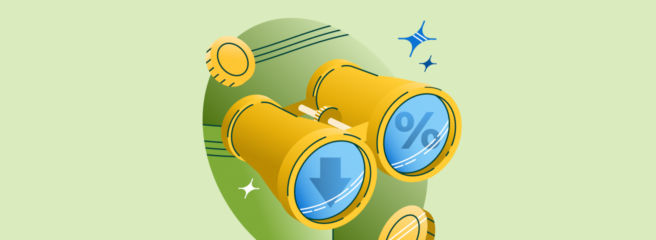
More than likely, you’ve heard the word “inflation” thrown around a lot over the last year. You’ve likely felt its effects, too. Higher grocery bills, paychecks that don’t stretch as far as they used to, and more expensive utility bills can make it harder to stick to your budget.
If you’re like many U.S. consumers, you may not know exactly what inflation is or how it can affect your life or finances—and that’s okay. Inflation hasn’t been a major concern for U.S. residents for more than 40 years.
We created this guide to help you understand the ins and outs of inflation in 2022. We’ll talk about what inflation is, how it’s measured, how it affects the economy, and how long it could stick around in 2022.
Definition of inflation
Inflation is a measure of how much prices have increased over a certain period of time. It is generally expressed as a percentage based on the price changes of a handful of select goods and services.
This basket includes a fixed combination of essential consumer expenses, such as:
- Food
- Clothing
- Housing costs
- Transportation
- Education
- Health care expenses
Economists track these prices to measure the rate of inflation. For example, if the cost of these goods and services increases by 5% from year to year, economists would say the inflation rate is 5%.
How does inflation work?
When inflation rises, prices also rise. Rising inflation also results in a loss of consumer purchasing power.
A loss of purchasing power means you’ll have to spend more money to buy the same products. Take your weekly grocery run. More than likely, you’ve noticed you’re spending more on groceries than you did a few years ago.
Although losing purchasing power sounds bad, there are some benefits. For instance, if you’ve been saving up to buy a TV or a new pair of shoes, now may be the best time to do so. Your cash will continue to lose value as inflation rises, but some goods will maintain or even increase in worth when inflation rates fall.
Borrowers may also benefit from inflation. For instance, consider a fixed-rate loan. As inflation increases, the money used to repay your loan loses value. That means you can repay all or part of the loan with money that’s worth less than it was when you took out your loan.
How is inflation measured?
To calculate the rate of inflation, subtract the original price from the new price. Then, divide the difference by the original cost and multiply the result by 100.
Consider this example: You purchased a pair of sneakers for $30 in 2010. Flash forward to 2022, and the same pair of sneakers costs $55.
Insert the original price and current price into the inflation rate equation to determine the price increase.
Inflation rate = ((Current Price – Original Price) / Original Price) x 100
Inflation rate = ((55 – 30) ÷ 30) x 100
Inflation rate = ((25) ÷ 30) x 100
Inflation rate = (.833) x 100
Inflation rate = 83%
It’s simple to measure the inflation rate of one product. However, tracking the U.S. inflation rate is much more complicated. Economists base their measurements on two pricing indexes: the Consumer Price Index (CPI) and the Personal Consumption Expenditures Index (PCE).
The CPI vs. PCE: What’s the difference?
The CPI tracks the costs of products and services purchased by average consumers. Think—coffee, milk, eggs, shoes, and other must-haves. Then, the CPI averages price changes based on each product or service’s relative weight within the basket.
The PCE index looks at consumer spending habits as a whole. Unlike the CPI, the PCE places less weight on volatile price changes in the food and energy categories. As a result, the PCE index tends to lag behind the CPI.
What causes inflation?
One of the main causes of inflation is an increase in the supply of money. Economic and global events can also influence the inflation rate.
It’s no secret that the last few years have been full of unexpected global events. We’ll get into some of the ways they’ve contributed to the current rate of inflation shortly. But first, let’s take a look at the three main types of inflation and their causes:
- Demand-pull inflation. An uptick in the demand for goods and services drives demand-pull inflation. It often follows an increase in money supply and credit availability.Cash-flush consumers are usually more positive about spending. This optimistic consumer sentiment and increased demand can result in a decreased supply of goods and services. And what follows high demand and low supply? Higher prices, of course.
- Cost-push inflation. Cost-push inflation occurs when the cost of production resources—like raw materials or wages—goes up. The rising production costs result in price increases. It’s also known as wage-push inflation.As the cost to produce goods increases, the amount of goods in production may decrease. The resulting low supply drives prices up as well.
- Built-in inflation. Finally, built-in inflation happens when consumers expect prices to rise because they’ve risen in the past. Workers then demand higher wages to combat a perceived risk of increased costs of living.Higher wages can drive up production costs and lead to price hikes on goods and services. The resulting wage-price cycle can worsen inflation even more.
What factors influence inflation?
Consumer purchasing habits, economic events, politics, and global conditions can all influence inflation. We are currently seeing some of these factors at play as a result of the COVID-19 pandemic.
What is causing inflation right now?
The COVID-19 pandemic had major repercussions around the world. As countries scrambled in response, manufacturing and production slowed. Shipping and transportation then stalled, resulting in less access to consumer goods.
At the same time, U.S. consumers had access to more cash, thanks to economic stimulus checks from the government. As a result, U.S. shopper demand increased as supply dwindled. The total effect of supply chain issues, increased money supply, and consumer demand drove prices even higher.
What does inflation do to the economy?
So far, we’ve discussed a lot of the downsides of inflation, like higher costs and lost purchasing power. However, small amounts of inflation can help stimulate economic growth and consumer spending—as long as wages increase alongside it. In fact, the Federal Reserve, the U.S.’s central bank, aims for a 2% increase in inflation each year.
Even so, inflation can have mixed effects on both consumers and businesses. Wondering how? Let’s take a look.
How inflation impacts consumers
Generally speaking, during times of rising inflation, prices increase. Consider a cup of coffee, for example. In 1995, your daily cup of Joe would have cost about $1.75. In 2022, you’re probably paying at least $3 for the same cup of coffee.
Sure, a $1.25 price increase may not seem like much. But on a larger scale, these inflationary changes can result in a loss of purchasing power.
How inflation impacts businesses
Inflation can hurt and help businesses. On the one hand, inflation can increase the costs of doing business. Raw materials may be more expensive and workers may demand higher wages to keep up with the cost of living. Limited supply may also force businesses to raise prices to manage demand.
On the other hand, inflation could drive up the prices of goods or services. Once prices hit a certain level, the profit margin may allow businesses to hire more workers.
So, how long does inflation last?
It’s hard to predict how long high inflation will last. In the 1970s and 80s, for example, the U.S. economy saw long stretches of record-high inflation.
Even so, many economists believe prices will begin to drop soon. Higher interest rates will help curb spending and borrowing. What’s more, supply chain conditions are improving and have already begun to help businesses catch up with consumer demand.
That doesn’t necessarily mean you’re in the financial clear, though. The world is still pivoting to adjust to the needs of a post-pandemic consumer base and workforce. Energy shortages and international events continue to create uncertainty and drive prices up, too.
Long story short: Although there’s no need to panic, it’s safe to say that the U.S. economy hasn’t quite recovered yet.
How bad is inflation right now?
As of March 2022, the current rate of inflation in the United States is about 8.5%, marking the highest jump since December 1981. For context, the inflation rate was about 1.8% in 2019.
You may be feeling the financial pinch, but you can take steps to protect yourself and improve your financial wellness.
For instance, you may decide to take a closer look at your spending habits to see how you can save more money each month. Or, perhaps you can take advantage of affordable interest rates and refinance expensive debt through a lending platform like Upstart. Doing so could lower your monthly payments and help you get out of debt faster.
Remember, inflation won’t last forever. But, the actions you take to prepare yourself financially today can help set you up for success now and in the future.






 Won't affect your credit score¹
Won't affect your credit score¹